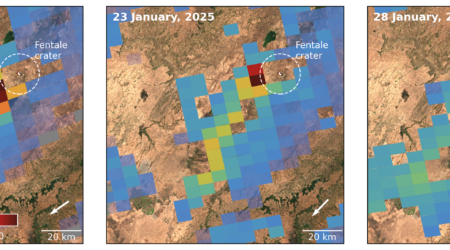Methane super-emitters revealed weekly using satellites and machine learning
The Dutch space instrument TROPOMI provides daily global methane concentration maps. This is important because methane is responsible for about a quarter of present-day global warming. There are individual sources that leak large amounts of methane, making them the low-hanging fruit in the fight against climate change. Researchers at SRON now successfully detect those methane plumes using machine learning (AI). The so-identified methane super-emitters have a larger climate impact than Dutch greenhouse gas emissions.

Methane is an extremely relevant greenhouse gas. This is due to methane’s ability to very effectively trap heat radiation that would normally dissipate into space. A ton of emitted methane retains thirty times more heat than a ton of CO2 over the course of a century despite methane’s much shorter lifetime (about 10 years) in the atmosphere.
The latter offers an opportunity to take climate measures that have an effect relatively quickly. Reducing methane emissions will result in an actual reduction of global methane concentrations within ten years, and thus a less enhanced greenhouse effect. So-called super-emitters represent the low-hanging fruit when it comes to emission reduction. Some oil and gas facilities, coal mines and landfills emit enormous amounts of methane. Relatively simple repairs can therefore yield major climate gains. But first, these super-emitters need to be found.
The Dutch TROPOMI instrument is the only satellite instrument that produces a global map of methane concentrations every day. Researchers from SRON Netherlands Institute for Space Research have now developed an algorithm that automatically discovers methane plumes in these maps using machine learning. It also automatically calculates the associated emissions based on the measured concentrations and concurrent wind speeds.
‘Before, we manually identified the largest emitters, but it remains difficult to search through the millions of TROPOMI pixels,’ says first author Berend Schuit (SRON). ‘A methane plume often only covers a few pixels. We now automatically get a list of detections from the machine learning model every day. We check those manually every week to make sure we are confident about the detections. What remains, dozens of methane plumes every week, we publish online. We communicate persistent leaks to other satellites with higher resolution so they can precisely identify the source. This information is used by the United Nations’ International Methane Emissions Observatory to find a solution together with the responsible companies or authorities.’
‘The dozens of methane plumes that TROPOMI detects every week really present a golden opportunity in the fight against global warming,’ says co-author Bram Maasakkers (SRON). ‘If it’s visible from space, it is serious. For the first time, we now get a good global picture of these super-emitters. In our publication, we describe the 2,974 plumes that we found in 2021; 45% originate from oil and gas facilities but we also see plumes from urban areas (35%) and coal mines (20%). We detect human-made emissions with a climate impact that is significantly larger than total greenhouse gas emissions of The Netherlands. In many cases, those leaks are easy to fix.’
Publication
Schuit, B. J., Maasakkers, J. D., Bijl, P., Mahapatra, G., van den Berg, A.-W., Pandey, S., Lorente, A., Borsdorff, T., Houweling, S., Varon, D. J., McKeever, J., Jervis, D., Girard, M., Irakulis-Loitxate, I., Gorroño, J., Guanter, L., Cusworth, D. H., and Aben, I.: Automated detection and monitoring of methane super-emitters using satellite data, Atmos. Chem. Phys., 23, 9071–9098, https://doi.org/10.5194/acp-23-9071-2023, 2023.

Duo of Satellites Detect Large Methane Emission from Ethiopian Volcano

Dutch space instrument SPEXone produces world map of aerosols

